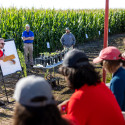Research strides kept UW-Madison in national spotlight in 2005
The university community gets reminded – and reminded again – of how difficult and challenging 2005 was on many fronts. But the year also delivered some tremendous gains where it matters most and is recognized the least – in the classrooms and laboratories.
Important research findings at UW–Madison, especially in the realm of stem cell and influenza research, attracted national headlines in 2005 and continued to cement UW–Madison’s reputation as one of the premier public research universities.
Washington Monthly also helped the cause in September with a No. 1 ranking for UW–Madison on research that leads to direct economic benefit.
Perhaps the biggest advance came in October with the announcement of a $16 million grant from the National Institutes of Health (NIH) to establish the federal government’s first and only National Stem Cell Bank, administered by the WiCell Research Institute.
But over the course of the year, incremental gains in the science of stem cells were starting to reveal the vast medical promise of the technology.
In December, UW–Madison heart specialist Timothy J. Kamp showed how all-purpose embryonic stem cells, transplanted into mouse hearts, shift gears and morph into functional forms of the major types of cells that compose the healthy heart. Also in December, neuroscientist Clive Svendsen demonstrated that engineered human brain progenitor cells, transplanted into the brains of animal models, can effectively integrate into the brain and deliver medicine where it is needed.
In January 2005, neurologist Su-Chun Zhang reported that, after years of trial and error, his team was able to coax human embryonic stem cells to become spinal motor neurons, critical nervous system pathways that relay messages from the brain to the rest of the body. And in April 2005, a team of UW–Madison stem cell scientists announced the creation of two major programs – a new regenerative medicine program and an interdisciplinary postdoctoral training program – that will advance stem cell research across the university for decades to come.
UW–Madison also made important contributions in the push to understand and combat influenza. Flu researcher Yoshi Kawaoka announced two findings in the fall: the discovery of a case in Vietnam of a young girl’s resistance to the Tamiflu vaccine; and the development of a new technology to speed bird flu vaccine production. Both advances gained added urgency in the context of global concerns over a bird flu pandemic.
Other research developments for UW–Madison in 2005 include, by category:
Philanthropy
- In May, alumni Simona and Jerome A. Chazen announced a $20 million gift to spearhead a major expansion of the Elvehjem Museum of Art, leading to a renaming of the museum in the Chazens’ honor.
- In March, the Oscar Rennebohm Foundation donated $15 million to help build the planned Interdisciplinary Research Complex (IRC), which will replace outdated research facilities and help to unify the UW Medical School on the west campus.
Learning
- In June, a “traveling classroom” of more than 40 students and faculty ventured into the cultural heart of the American West in a course called “The Santa Fe Trail: In Search of the Multiracial West.” The 15-day, 3,000-mile odyssey explored issues of racial diversity and civil rights across a variety of western landmarks in Oklahoma, Texas, New Mexico, Arizona and Colorado.
- In October, a report on the academic profile of the 2005 freshman class revealed 426 “number ones,” based on their high school academic rankings.
- In July, a team that must be the pride of hungry roommates everywhere – the UW–Madison Product Development Team – captured first place in a national product development contest for “Healthy sTarts,” a granola cup coated with strawberry-flavored yogurt and topped with fresh fruit. It was the team’s third national title this decade.
- In April, the School of Journalism and Mass Communication received two $1 million gifts that will pay major dividends in the classroom. The Capital Times’ Evjue Foundation gift provides for an endowed professorship in journalism, while a gift from former Wisconsin State Journal publisher James Burgess established an endowed chair in journalism ethics.
- In Fall 2005, UW–Madison’s PEOPLE program, which has helped prepare hundreds of Wisconsin students of color for college admission, reached into the elementary grades to help a new generation look to the future. It has already helped launch more than 250 students into university careers.
Science
- In September, the university’s prominent role in the development of the South African Large Telescope (SALT), one the world’s largest and most powerful, bore fruit when the telescope went online and produced its first images.
- In November, a chilling report by climatologist Jonathan Patz revealed that the most devastating health effects of climate change – estimated to be at least 5 million cases of illness and more than 150,000 deaths every year – will fall on the countries least responsible for creating greenhouse gases.
- In September and October, two different studies that revealed the ancient origins of the world’s most ubiquitous food crops – maize and potatoes – attracted lots of attention.
- In June, an international team led by UW–Madison engineer Paul Nealy demonstrated a new approach to the manufacturing of nanotechnology devices, illustrating a way to make templates for self-assembly of materials at the atomic scale.
Federal grants
- UW-Madison received announcement of four federal grants of $15 million or more in 2005 that will lead to greater productivity in the fields of protein structure, transportation, nanotechnology and children’s health.
Facilities
- The university put the finishing touches on a master plan that will guide campus growth for the next two decades.
- Meanwhile, a number of major, multi-year projects are already in the works, including new microbial science and medical diagnostics buildings.
- The campus also took steps to further protect a cherished resource — its property bordering the Lake Mendota shoreline — by designating the Lakeshore Nature Preserve.
Compiled by Brian Mattmiller, (608) 262-0930, bsmattmi@wisc.edu
Tags: research




